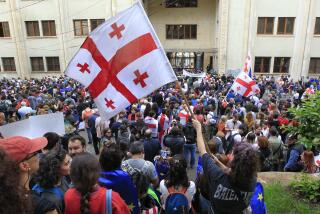Lithuania, Latvia and Estonia: Soviet States Going Separate Ways
- Share via
Last week the new Supreme Soviet granted wide-ranging economic autonomy to Estonia and Lithuania (with Latvia soon to follow), a new watershed in Moscow’s wrenching efforts to reform the decaying Soviet system.
For reform-minded officials this decision represented a recognition of the Balts as trailblazers in the turbulent politics of perestroika and a welcome chance to use this small region as a laboratory for economic experimentation. If successful, lessons could then be applied to the rest of the country for the common good.
For conservatives and the party bureaucracy, however, the decision is an ominous concession, perhaps leading to the de facto secession of the Baltic republics and ultimate disintegration of the Soviet empire. Such fears are not without foundation: An overwhelming majority of native Balts fervently hope economic independence is a way station on the way to full political independence.
The tiny Baltic republics have become a catalyst for both conservative fears and national aspirations, reverberating far beyond the region’s borders. They are a microcosm and a harbinger of the much larger struggle for national, political and economic emancipation unfolding across the country.
At first glance, the Baltic states are a unlikely place for a radical nationalist challenge to the regime. Economically quite prosperous by Soviet standards and Western by culture, Balts are highly educated, industrious, dignified people-- not given to extremism. Yet behind this facade lies a bitter collective memory, as victims of the more hideous practices of Soviet totalitarianism.
Having been annexed in 1940 by force of arms into the Soviet state, with Hitler’s blessing, the Baltic republics were subjected to a Sovietizing campaign of unprecedented brutality. Wave after wave of repression, executions and massive deportations continued into the 1950s. The genocidal fury of the Stalinist regime was further provoked by determined armed resistance--tens of thousands of casualties on both sides.
When it was finally over, the Baltic elites had been largely annihilated, the people decimated. Hundreds of thousands were killed. More than 10% of the total population languished in Siberian labor camps. In the stark words of the current Lithuanian Communist leadership, it was a “policy of extermination.”
Post-Stalin normalization brought an end to the reign of terror but not to Moscow’s heavy-handed domination. National feelings and culture continued to be suppressed. Two policies particularly alienated the natives because of their perceived anti-national implications: a massive migration of Russians into the region and cultural Russification efforts. As a result of migration, Latvians risk becoming a minority in their own country, while native Estonians have shrunk from close to 90% of the population before the war to a little more than 60% today. Russian was imposed as the dominant language; even Lithuanian literature dissertations had to be written in Russian.
Deep resentment against the regime was never far below the surface; it found new expression in a powerful nationalist revival during the ‘70s. This profound hostility toward the system and a growing nationalist fervor have been unleashed by Mikhail S. Gorbachev’s liberalization and give impetus to a quiet political revolution. Recognized national movements in all three republics have challenged the system and Moscow rule under the guise of support for perestroika . Their ultimate agenda is unmistakable--full political and economic sovereignty and eventual separation from the Soviet Union.
What must be particularly troublesome for the Kremlin is that these unabashedly nationalist forces not only enjoy the support of the masses, but they have to a large extent enlisted local communist officials in the cause. There are laws being passed and political realities created in the Baltics today that directly undermine Soviet rule and create conditions for transition to a non-socialist system. Local languages have been given official priority over Russian. In-migration has been made more difficult. And an increasing number of organizations, including the Lithuanian Communist Youth League, have declared independence from parent Soviet organizations.
In Lithuania, government has passed a law giving land back to the peasants, free and in perpetuity, thus dooming collective agriculture, the backbone of control in the countryside. In Latvia, an independent news agency bypasses official Soviet information sources. In Estonia, local government has demanded the right to control military units stationed on its territory. Finally, the Communist parties themselves seem to be considering a separation from Moscow leadership, in order to become legitimate national institutions. They have even indicated willingness to compete in the framework of a multiparty system.
Does this mean Baltic independence is around the corner? Clearly, no. However fervent the national desires, neither Gorbachev nor anybody else in the Kremlin could afford to let the Balts go their own way. As distinct as the three republics are, their problems in fact typify other Soviet nations. So, too, their hopes and aspirations. National movements are already in existence in many other republics and language protection laws have been passed from Moldavia to Tadzhik. Economic independence is on everybody’s agenda, as is some form of political autonomy. Even in Russia, there is recent talk of strengthening the “sovereign rights” of the Russian republic. To grant the Balts sovereignty would surely accelerate the unraveling of the Soviet state as we know it.
Such unraveling is inevitable and desirable. Only after the collapse of the current imperial state will some or all of the Soviet nations--Russia included--be able to reunite as free states in a federation based on common economic interests.
But the future is not here yet; the forces that have built and profited from the system are far from defeated. At about the time of the Supreme Soviet decision, a Communist Party Central Committee meeting revealed open and unprecedented hostility among senior members toward Gorbachev’s course. One after another official decried current policies and predicted doom if they were not radically changed. They called openly for reimposition of strict party control, reigning in the press and using administrative measures against the “dark forces,” which, speculating on perestroika , “are uniting on the basis of nationalism, corruption and anti-Sovietism.”
Whether these powerful conservative forces, perhaps in alliance with the military, would be able to force Gorbachev to change course or even overthrow him is far from certain. What is certain is the struggle, one that will decide the future of the Soviet Union and the Balts, now enters a critical stage.
More to Read
Sign up for Essential California
The most important California stories and recommendations in your inbox every morning.
You may occasionally receive promotional content from the Los Angeles Times.













